-
 Bitcoin
Bitcoin $106,437.2012
0.82% -
 Ethereum
Ethereum $2,442.5287
0.82% -
 Tether USDt
Tether USDt $1.0005
-0.02% -
 XRP
XRP $2.1812
-0.27% -
 BNB
BNB $645.1327
0.45% -
 Solana
Solana $146.2379
0.39% -
 USDC
USDC $0.9999
-0.01% -
 TRON
TRON $0.2751
0.92% -
 Dogecoin
Dogecoin $0.1662
-0.23% -
 Cardano
Cardano $0.5827
-1.22% -
 Hyperliquid
Hyperliquid $37.5225
0.04% -
 Bitcoin Cash
Bitcoin Cash $479.0877
4.02% -
 Sui
Sui $2.7846
-3.27% -
 Chainlink
Chainlink $13.3576
0.84% -
 UNUS SED LEO
UNUS SED LEO $9.0252
-1.20% -
 Stellar
Stellar $0.2455
-1.07% -
 Avalanche
Avalanche $18.0680
-1.81% -
 Toncoin
Toncoin $2.8948
-1.07% -
 Shiba Inu
Shiba Inu $0.0...01164
-1.65% -
 Litecoin
Litecoin $85.0637
-0.06% -
 Hedera
Hedera $0.1526
-0.89% -
 Monero
Monero $316.2941
0.78% -
 Ethena USDe
Ethena USDe $1.0003
-0.04% -
 Polkadot
Polkadot $3.4113
-1.87% -
 Dai
Dai $1.0000
-0.01% -
 Bitget Token
Bitget Token $4.4488
5.16% -
 Uniswap
Uniswap $7.1740
3.09% -
 Pi
Pi $0.5968
11.43% -
 Pepe
Pepe $0.0...01010
-0.65% -
 Aave
Aave $264.3189
0.40%
What does it mean when the KDJ indicator is blunt in the overbought area for 7 consecutive trading days?
If the KDJ indicator remains blunt in overbought territory for 7 straight days, it may signal strong bullish momentum or an impending correction in crypto markets.
Jun 25, 2025 at 08:21 am
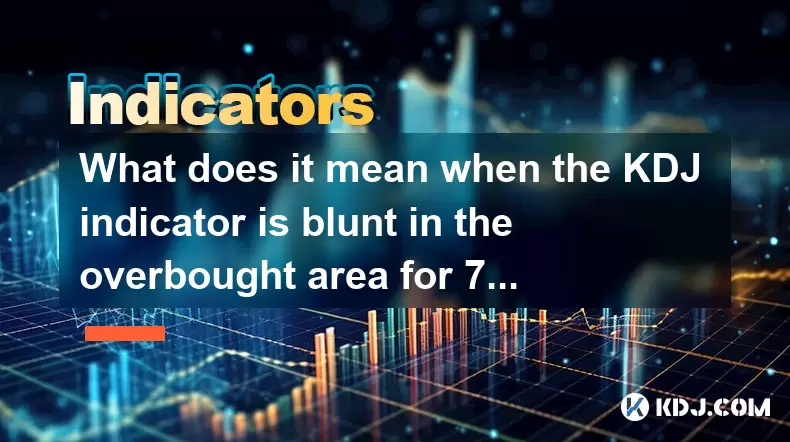
Understanding the KDJ Indicator in Cryptocurrency Trading
The KDJ indicator, also known as the stochastic oscillator, is a momentum-based technical analysis tool widely used in cryptocurrency trading. It consists of three lines: the %K line (fast stochastic), the %D line (slow stochastic), and the %J line (which reflects the divergence between %K and %D). The primary function of the KDJ indicator is to identify overbought or oversold conditions in an asset’s price movement.
In the context of cryptocurrencies, where volatility is high and trends can reverse quickly, understanding how the KDJ behaves becomes crucial for traders. When the KDJ indicator remains blunt—meaning the %K line does not cross below the %D line—in the overbought area for 7 consecutive trading days, it signals a specific condition that traders should interpret carefully.
Note:
An overbought condition typically occurs when the %K value rises above 80, indicating potential exhaustion in upward momentum.What Does It Mean for the KDJ to Be Blunt?
When the KDJ is described as "blunt," it refers to the situation where the %K line fails to cross below the %D line despite being in the overbought zone. Normally, in a healthy uptrend, the %K line would dip slightly after reaching overbought levels, signaling a possible pullback or consolidation phase. However, if this crossover doesn’t occur for several days, the indicator is said to be "blunt."
This phenomenon suggests that the bullish momentum may still be strong enough to keep prices elevated even though they are technically overbought. In the crypto market, where sentiment and macroeconomic factors heavily influence price action, such bluntness can persist longer than expected.
- Bluntness indicates indecision or continued strength: If the price continues to rise despite the KDJ being overbought and blunt, it could signal strong buying pressure.
- Risk of false signals: A prolonged stay in overbought territory without a reversal might result in misleading sell signals if interpreted without additional context.
Why 7 Consecutive Days Is Significant in Crypto Markets
Cryptocurrency markets operate 24/7, but traders often use daily timeframes to analyze trends and make decisions. Therefore, 7 consecutive trading days equate to roughly one week of sustained overbought and blunt KDJ behavior.
This duration is significant because:
- Extended periods in overbought zones are rare: In most cases, prices tend to correct or consolidate after reaching extreme levels.
- Market psychology shifts: Traders who were expecting a pullback may start questioning whether the trend has changed or whether they missed a rally.
- Volume and order flow dynamics change: Sustained bullishness over 7 days may indicate institutional or whale accumulation, which can distort typical technical signals.
Important:
In volatile assets like Bitcoin or Ethereum, a 7-day overbought and blunt KDJ pattern can sometimes precede a sharp correction or continuation, depending on external catalysts.How to Interpret This Signal in Practice
Interpreting the KDJ being blunt in the overbought area for 7 consecutive trading days requires more than just looking at the indicator itself. Here’s a step-by-step approach to analyzing this scenario:
- Confirm with volume data: Check whether the volume has been increasing or decreasing during these 7 days. Rising volume alongside rising prices supports the continuation of the trend.
- Look for divergences: Compare price action with the KDJ. If the price makes new highs but the KDJ does not, it may indicate weakening momentum.
- Use candlestick patterns: Pay attention to candle formations near resistance levels. Long upper shadows or bearish engulfing candles may hint at an imminent reversal.
- Overlay other indicators: Combine RSI or MACD with the KDJ to get a clearer picture. For instance, if RSI is also showing signs of topping out, the risk of a pullback increases.
- Assess broader market conditions: Look at news events, regulatory developments, or macroeconomic factors that could justify extended overbought conditions.
Traders should avoid making decisions based solely on this signal. Instead, treat it as a warning sign that requires deeper investigation before entering a trade.
Risks and Pitfalls of Acting on This Signal Alone
Relying solely on the KDJ being blunt in the overbought zone for 7 days can lead to costly mistakes, especially in cryptocurrency trading where markets can defy traditional technical logic for extended periods.
Some risks include:
- False sell signals: The market may continue to rise despite overbought readings, leading to missed gains or early exits.
- Whipsaw movements: Sudden reversals followed by rapid recoveries can trap traders who act too quickly.
- Overemphasis on technicals without fundamentals: Especially in altcoins, pump-and-dump schemes or social media hype can cause artificial overbought conditions.
To mitigate these risks:
- Always use stop-loss orders when shorting or going long based on technical indicators.
- Consider using trailing stops if riding a strong trend.
- Avoid overleveraging when entering trades under ambiguous conditions.
Critical Tip:
Never assume that an overbought indicator automatically means a reversal is imminent. Strong trends can sustain overbought conditions for weeks.Frequently Asked Questions (FAQ)
Q1: Can the KDJ indicator be trusted in highly volatile crypto markets?
Yes, but with caution. The KDJ works best when combined with other tools like moving averages or volume indicators. In highly volatile environments, it may generate frequent false signals.
Q2: What should I do if the KDJ stays blunt in the oversold area for several days?
A blunt KDJ in the oversold zone may indicate hidden buying pressure or capitulation. Similar to overbought scenarios, traders should look for confirmation from other indicators and price action before assuming a reversal.
Q3: Is there a difference between the KDJ being blunt in stocks versus cryptocurrencies?
Yes. Cryptocurrencies exhibit higher volatility and less predictable price behavior. As a result, KDJ patterns in crypto may last longer and provide less reliable signals compared to traditional stock markets.
Q4: How can I visually identify a blunt KDJ on my charting platform?
On most platforms like TradingView or Binance's native tools, you'll see the %K and %D lines plotted together. A blunt KDJ appears when the %K line hovers closely around or just above the %D line without crossing it, even as both remain in the overbought region.
Disclaimer:info@kdj.com
The information provided is not trading advice. kdj.com does not assume any responsibility for any investments made based on the information provided in this article. Cryptocurrencies are highly volatile and it is highly recommended that you invest with caution after thorough research!
If you believe that the content used on this website infringes your copyright, please contact us immediately (info@kdj.com) and we will delete it promptly.
- Bitcoin Price Soars to $106,596: Is This the Recovery We've Been Waiting For?
- 2025-06-25 12:25:14
- XRP Ledger's New Era: Batch Transactions and Token Escrow Take Center Stage
- 2025-06-25 12:45:12
- JasmyCoin: Price Prediction & the Quest for New Highs
- 2025-06-25 12:25:14
- Arctic Pablo Coin: The Meme Coin Primed for Lift-Off? Plus, Bonk & SHIB Updates!
- 2025-06-25 12:45:12
- BigBear.ai, AMD, QuantumScape: Stocks Soar and Solid-State Batteries Get Real!
- 2025-06-25 12:50:13
- Bitcoin, Ethereum, and the Iran-Israel Ceasefire: A Crypto Market Update
- 2025-06-25 13:05:13
Related knowledge
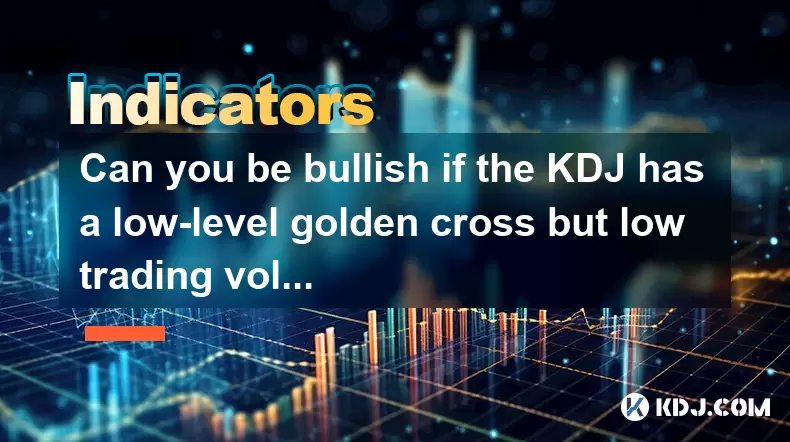
Can you be bullish if the KDJ has a low-level golden cross but low trading volume?
Jun 25,2025 at 03:14pm
Understanding the KDJ Indicator in Cryptocurrency TradingThe KDJ indicator, also known as the stochastic oscillator, is a momentum-based technical analysis tool widely used in cryptocurrency trading. It comprises three lines: the %K line (fast stochastic), the %D line (slow stochastic), and the J line (divergence value). These lines oscillate between 0 ...
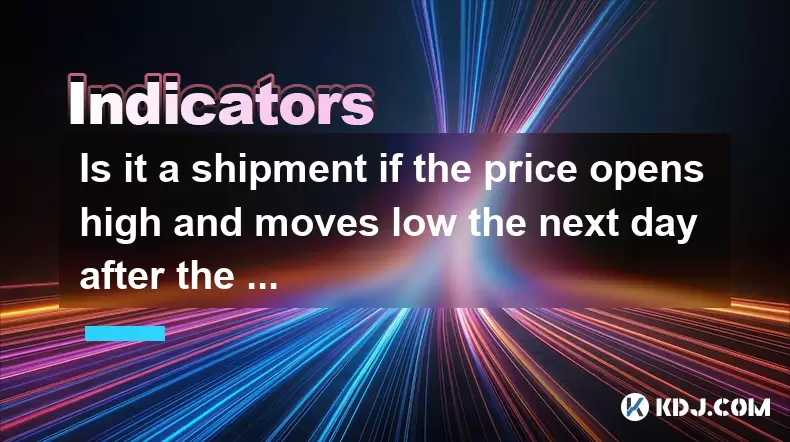
Is it a shipment if the price opens high and moves low the next day after the daily limit with huge volume?
Jun 25,2025 at 12:56pm
Understanding the Concept of a Shipment in Cryptocurrency TradingIn cryptocurrency trading, the term shipment refers to a scenario where large volumes of an asset are sold off rapidly, often leading to a significant price drop. This is typically associated with whale activity or coordinated selling by major holders. When traders observe certain patterns...
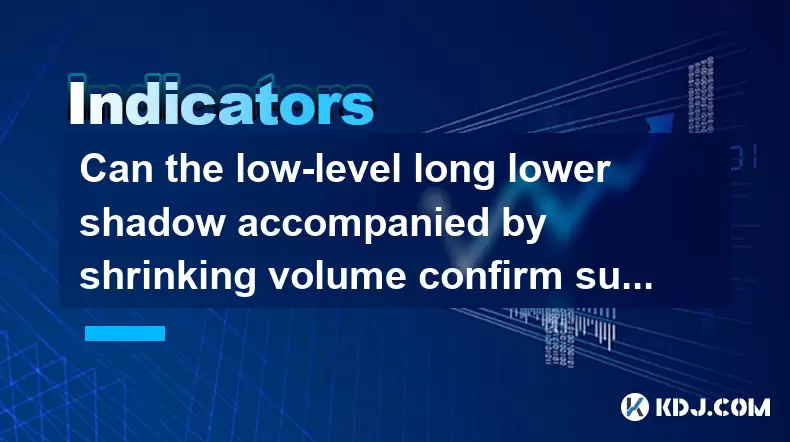
Can the low-level long lower shadow accompanied by shrinking volume confirm support?
Jun 25,2025 at 03:08pm
Understanding the Long Lower Shadow Candlestick PatternA long lower shadow candlestick pattern occurs when a candle closes near its high but has a significantly long lower wick, indicating that sellers pushed prices down during the session but were met with strong buying pressure that drove the price back up. This pattern is often seen as a potential si...
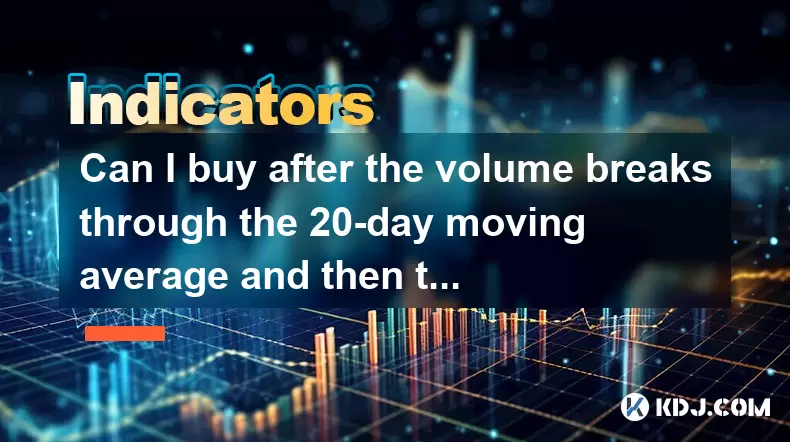
Can I buy after the volume breaks through the 20-day moving average and then the volume shrinks and then the callback is pulled back?
Jun 25,2025 at 12:00pm
Understanding Volume and Moving Averages in Cryptocurrency TradingIn the world of cryptocurrency trading, volume and moving averages are two critical indicators that traders rely on to make informed decisions. The 20-day moving average (MA) is a popular tool used to identify trends and potential entry or exit points. When volume breaks through this aver...
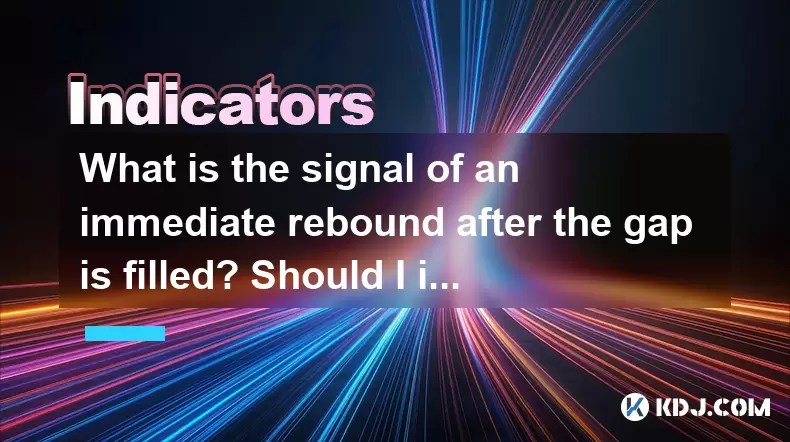
What is the signal of an immediate rebound after the gap is filled? Should I intervene?
Jun 25,2025 at 01:15pm
Understanding Gaps in Cryptocurrency TradingIn cryptocurrency trading, a gap occurs when the price of an asset jumps from one level to another without any trading happening in between. This typically happens during periods of high volatility or after significant news events that impact market sentiment overnight or over weekends. The phenomenon is commo...
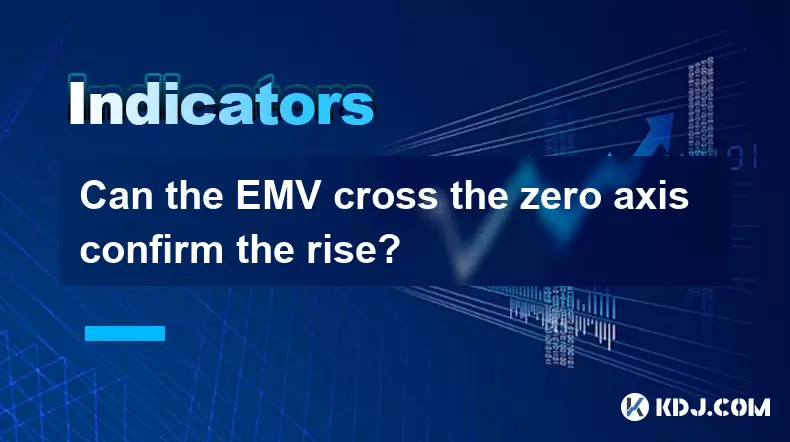
Can the EMV cross the zero axis confirm the rise?
Jun 25,2025 at 11:14am
Understanding the EMV Indicator in Cryptocurrency TradingThe Ease of Movement Value (EMV) is a technical analysis indicator commonly used by traders to assess the relationship between price and volume. In the cryptocurrency market, where volatility is high and trends can reverse quickly, understanding how to interpret EMV becomes crucial for making info...

Can you be bullish if the KDJ has a low-level golden cross but low trading volume?
Jun 25,2025 at 03:14pm
Understanding the KDJ Indicator in Cryptocurrency TradingThe KDJ indicator, also known as the stochastic oscillator, is a momentum-based technical analysis tool widely used in cryptocurrency trading. It comprises three lines: the %K line (fast stochastic), the %D line (slow stochastic), and the J line (divergence value). These lines oscillate between 0 ...

Is it a shipment if the price opens high and moves low the next day after the daily limit with huge volume?
Jun 25,2025 at 12:56pm
Understanding the Concept of a Shipment in Cryptocurrency TradingIn cryptocurrency trading, the term shipment refers to a scenario where large volumes of an asset are sold off rapidly, often leading to a significant price drop. This is typically associated with whale activity or coordinated selling by major holders. When traders observe certain patterns...

Can the low-level long lower shadow accompanied by shrinking volume confirm support?
Jun 25,2025 at 03:08pm
Understanding the Long Lower Shadow Candlestick PatternA long lower shadow candlestick pattern occurs when a candle closes near its high but has a significantly long lower wick, indicating that sellers pushed prices down during the session but were met with strong buying pressure that drove the price back up. This pattern is often seen as a potential si...

Can I buy after the volume breaks through the 20-day moving average and then the volume shrinks and then the callback is pulled back?
Jun 25,2025 at 12:00pm
Understanding Volume and Moving Averages in Cryptocurrency TradingIn the world of cryptocurrency trading, volume and moving averages are two critical indicators that traders rely on to make informed decisions. The 20-day moving average (MA) is a popular tool used to identify trends and potential entry or exit points. When volume breaks through this aver...

What is the signal of an immediate rebound after the gap is filled? Should I intervene?
Jun 25,2025 at 01:15pm
Understanding Gaps in Cryptocurrency TradingIn cryptocurrency trading, a gap occurs when the price of an asset jumps from one level to another without any trading happening in between. This typically happens during periods of high volatility or after significant news events that impact market sentiment overnight or over weekends. The phenomenon is commo...

Can the EMV cross the zero axis confirm the rise?
Jun 25,2025 at 11:14am
Understanding the EMV Indicator in Cryptocurrency TradingThe Ease of Movement Value (EMV) is a technical analysis indicator commonly used by traders to assess the relationship between price and volume. In the cryptocurrency market, where volatility is high and trends can reverse quickly, understanding how to interpret EMV becomes crucial for making info...
See all articles
























































































